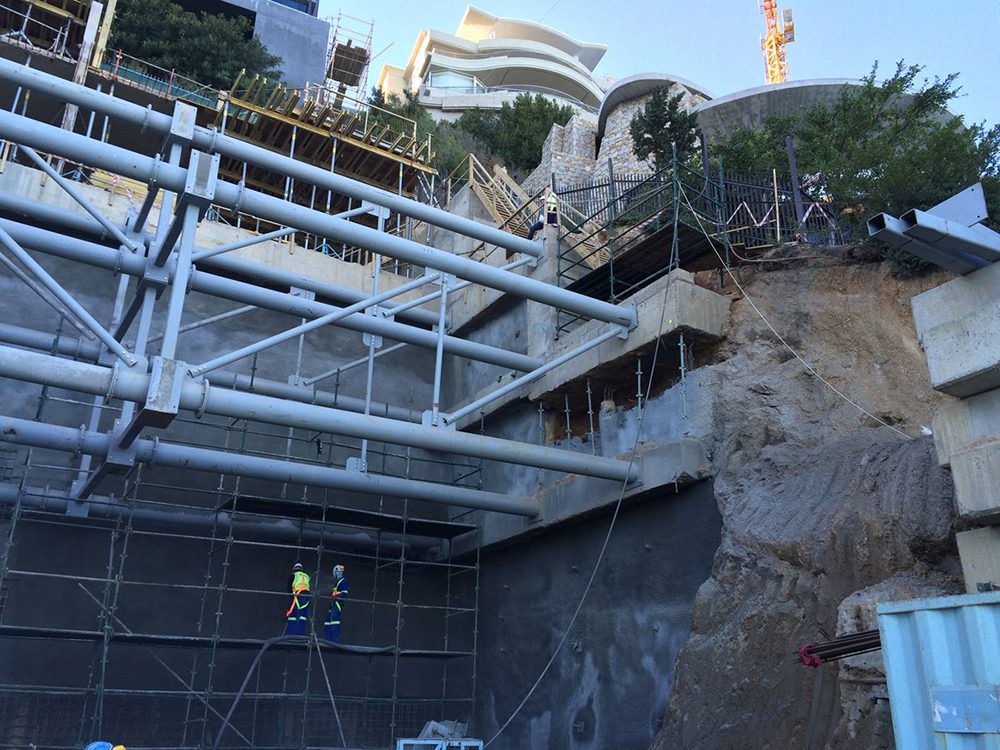
JG Afrika’s involvement in the technically complex residential development at 145 Kloof Road at the foot of Lions Head in Clifton earned the firm second place in the South African Institution of Civil Engineering Western Cape Branch Awards.
Unique designs and intricate construction processes were deployed in building a three-level basement for the six-storey structure.
JG Afrika and Franki Africa designed an alternative to conventional ground stabilisation systems during construction which ultimately incorporated the structure’s final state.
The close proximity of existing properties to the building’s boundary eliminated the possibility of conventional soil anchoring systems and the slightest ground movements during construction to avoid damaging neighbouring structures.
Bobby Jarratt, JG Afrika’s senior engineer, says the system also had to perform in weathered residual soils, soft to medium rock at depths of between 12 m and 15 m, as well as large intermittent boulders, before reaching the granite bedrock. The perched water-table during the rainy winter season added to the complexity.
“We designed it in three months so as not to delay Franki Africa which had already been appointed by the time that we understood the true extent of the risk associated with crossing the site boundary using traditional stabilisation methods,” Jarratt says.
The RC box system comprises tension anchors rooted within the property boundaries to resist horizontal forces and conventional vertical piles that intercepted the slip-circle plane.
Construction started with the establishment of a small working platform at second terrace level where a 13 m-high rear slope was excavated at 60°. It was temporarily stabilised using soil anchors and covered with mesh and sprayed with gunite. The installation of temporary anchors was carefully monitored to ensure that none crossed the property boundary.
Drilling rigs were lifted and placed onto the 14 m-high platform to insert the 300 mm-diameter rotary percussion soldier piles and tension ground anchors at 10° to the vertical, to form the temporary side walls of the system.
Within the platform area, vertical piles of up to 25 m in length and tension anchors at 60° to the horizontal were then socketed into hard rock to resist slip circle failure and the horizontal sliding forces generated from the eventual rear vertical retaining wall.
A 500 mm-thick foundation slab was then constructed and the excavation of the rear face followed in controlled 3 m widths to mitigate the chance of slope failure. The retaining wall was built up to the 5 m retained height sequentially to ensure stability.
Construction of the basement at the lower terrace level commenced with the excavation in 3 m heights and installation of a conventional soil anchoring system along the rear face, as this was well within the property boundary.
A structural steel propping system was placed to shore the side walls during excavation as these faces were still in close proximity to the property boundary. Steel propping members were positioned to coincide with the final state floor levels which would replace the propping once constructed.
Approximately 20 tonnes of temporary structural steel props were installed. Spanning 22 m, they were fabricated in sections and assembled on site, and detailed assembly drawings were generated for the contractor. Members were designed to withstand buckling under the significant loads allowing the contracting teams to complete the 14 m-deep excavation.
The steel propping was removed once the concrete slabs, tied into the edge beams located just below propping positions, had sufficiently cured.
Minimal ground movements were detected during the entire two-year-long build.
